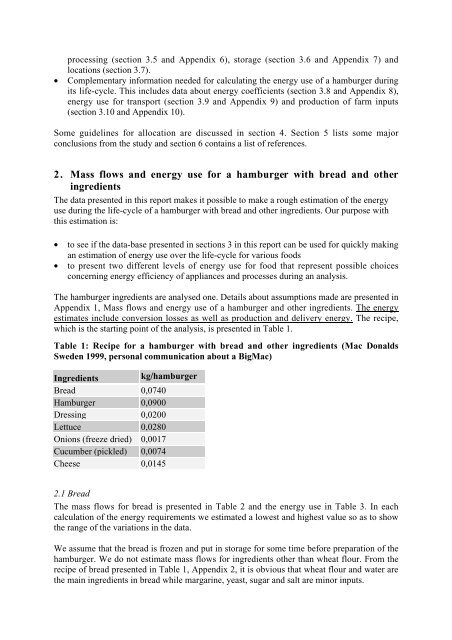Energy Use in the Food Sector: A data
Energy Use in the Food Sector: A data
Energy Use in the Food Sector: A data
Create successful ePaper yourself
Turn your PDF publications into a flip-book with our unique Google optimized e-Paper software.
process<strong>in</strong>g (section 3.5 and Appendix 6), storage (section 3.6 and Appendix 7) and<br />
locations (section 3.7).<br />
• Complementary <strong>in</strong>formation needed for calculat<strong>in</strong>g <strong>the</strong> energy use of a hamburger dur<strong>in</strong>g<br />
its life-cycle. This <strong>in</strong>cludes <strong>data</strong> about energy coefficients (section 3.8 and Appendix 8),<br />
energy use for transport (section 3.9 and Appendix 9) and production of farm <strong>in</strong>puts<br />
(section 3.10 and Appendix 10).<br />
Some guidel<strong>in</strong>es for allocation are discussed <strong>in</strong> section 4. Section 5 lists some major<br />
conclusions from <strong>the</strong> study and section 6 conta<strong>in</strong>s a list of references.<br />
2. Mass flows and energy use for a hamburger with bread and o<strong>the</strong>r<br />
<strong>in</strong>gredients<br />
The <strong>data</strong> presented <strong>in</strong> this report makes it possible to make a rough estimation of <strong>the</strong> energy<br />
use dur<strong>in</strong>g <strong>the</strong> life-cycle of a hamburger with bread and o<strong>the</strong>r <strong>in</strong>gredients. Our purpose with<br />
this estimation is:<br />
• to see if <strong>the</strong> <strong>data</strong>-base presented <strong>in</strong> sections 3 <strong>in</strong> this report can be used for quickly mak<strong>in</strong>g<br />
an estimation of energy use over <strong>the</strong> life-cycle for various foods<br />
• to present two different levels of energy use for food that represent possible choices<br />
concern<strong>in</strong>g energy efficiency of appliances and processes dur<strong>in</strong>g an analysis.<br />
The hamburger <strong>in</strong>gredients are analysed one. Details about assumptions made are presented <strong>in</strong><br />
Appendix 1, Mass flows and energy use of a hamburger and o<strong>the</strong>r <strong>in</strong>gredients. The energy<br />
estimates <strong>in</strong>clude conversion losses as well as production and delivery energy. The recipe,<br />
which is <strong>the</strong> start<strong>in</strong>g po<strong>in</strong>t of <strong>the</strong> analysis, is presented <strong>in</strong> Table 1.<br />
Table 1: Recipe for a hamburger with bread and o<strong>the</strong>r <strong>in</strong>gredients (Mac Donalds<br />
Sweden 1999, personal communication about a BigMac)<br />
Ingredients kg/hamburger<br />
Bread 0,0740<br />
Hamburger 0,0900<br />
Dress<strong>in</strong>g 0,0200<br />
Lettuce 0,0280<br />
Onions (freeze dried) 0,0017<br />
Cucumber (pickled) 0,0074<br />
Cheese 0,0145<br />
2.1 Bread<br />
The mass flows for bread is presented <strong>in</strong> Table 2 and <strong>the</strong> energy use <strong>in</strong> Table 3. In each<br />
calculation of <strong>the</strong> energy requirements we estimated a lowest and highest value so as to show<br />
<strong>the</strong> range of <strong>the</strong> variations <strong>in</strong> <strong>the</strong> <strong>data</strong>.<br />
We assume that <strong>the</strong> bread is frozen and put <strong>in</strong> storage for some time before preparation of <strong>the</strong><br />
hamburger. We do not estimate mass flows for <strong>in</strong>gredients o<strong>the</strong>r than wheat flour. From <strong>the</strong><br />
recipe of bread presented <strong>in</strong> Table 1, Appendix 2, it is obvious that wheat flour and water are<br />
<strong>the</strong> ma<strong>in</strong> <strong>in</strong>gredients <strong>in</strong> bread while margar<strong>in</strong>e, yeast, sugar and salt are m<strong>in</strong>or <strong>in</strong>puts.

















